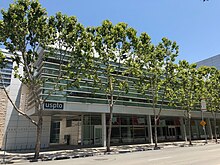San Jose City Hall
It consists of an 18-story tower, an iconic glass rotunda, and a city council chamber wing, laid out within a two-block-long public square known as San José Civic Plaza.Similar to a rural American courthouse, it served as the main administrative building, with an assembly, court, and jail, and offices for the comisionado and alcalde.[16] On July 14, 1846, during the Mexican–American War, Captain Thomas Fallon's men took over the juzgado and raised the American flag over San José for the first time at this location.[30][31] At the height of anti-Chinese sentiment, the city council prohibited the use of Chinese labor,[29] even though the building was located across from the Market Street Chinatown.Bartholomew presented his plan on August 6, 1931, calling for new city and county administration buildings, a post office, museums, and a civic auditorium.[37] The new city hall would sit on 10.1 acres (4.1 ha) of donated land about one-half mile (0.80 km) north of the downtown area.[15][42] Moving thousands of city employees out of the downtown area exacerbated the urban decay that resulted in part from Hamann's aggressive program of suburban development.A new city hall would bolster the urban renewal program that had finally begun turning the vast expanse of downtown parking lots into a retail and entertainment district.[1] In August 1998, an urban design study by Sasaki Associates recommended a site along East Santa Clara Street near San Jose State University, with the intention of expanding the downtown core eastward.[50] In 1999, Mayor Ron Gonzales and the city council rejected all of Meier's first round of proposals, which called for a low-rise office block, and insisted on a more iconic structure that featured a rotunda.[14][30] However, former mayor Albert J. Ruffo successfully sued the city to stop it from using San Jose Redevelopment Agency funds for the project.[39] Starbucks planned to open a café at the complex but pulled out in 2014 amid debate over whether the city should enforce living wage rules at the location.[59][60] The front plaza facing East Santa Clara Street features "Waterscape", a 2005 water sculpture by Anna Valentina Murch and Douglas Hollis.[2][63] A 2005 series of 16 art installations by Andrew Leicester, titled "Parade of Floats", adorns various sidewalks in the neighborhood immediately surrounding city hall.[62][64] The floor of the westbound City Hall bus rapid transit stop features a collage that illustrates the patent filing process.[65] A 9-foot-tall (2.7 m), 4,000-pound (1,800 kg) statue of Christopher Columbus was installed in the lobby of the Civic Center facility in 1958 to celebrate the local Italian-American community.[1][11] The tower employs daylighting techniques, including high ceilings, a thin floor plan, and side elevator shafts, to take advantage of an average 300 days of sun annually and reduce artificial lighting costs.The previous city hall also attracted political demonstrations, including marches following the police shooting deaths of John Henry Smith in 1971[70] and Bich Cau Thi Tran in 2003.[72] Civic Plaza attracts relatively little foot traffic apart from organized events, owing in part to heat reflecting off City Hall and a lack of shade.A light art installation titled "Sonic Runway" was located in the front plaza from November 3, 2017, to March 9, 2018, as part of the Playa to the Paseo partnership between the city and the Burning Man project.[78] However, subsequent budget cuts forced the project to be scaled back to an extension of an existing light rail line that does not serve City Hall.[80] The City Hall rotunda appears in the 2009 Bollywood film Love Aaj Kal as the corporate headquarters of the fictional architectural firm Golden Gate Engineering.









PostmodernSan Jose, CaliforniaCoordinatesU.S. Patent & Trademark OfficeRichard MeierTurner Constructionmunicipal governmentDowntown San JosePritzker PrizePostmodern stylepublic squarefourth tallest building in San Joseits historydot-com bubbleGetty CenterLos AngelesBarcelona Museum of Contemporary ArtBarcelonaThe Hague City HallLe CorbusierBeaux-ArtsSan FranciscoOaklandsecretariattallest building in San JoseTower 88planetariumUnited States Capitol rotundacurtain wallRon Gonzalesopen governmentSan Jose City CouncilUnited States Patent and Trademark OfficeSilver CreekCalaverasHaywardSan Andreasshear wallsmoment-resisting frameRío de GuadalupecourthouseCalifornia Historical LandmarkJuan Bautista de Anza National Historic TrailAlta CaliforniaMexican–American WarThomas FallonAmerican flagJosiah Beldenplaza mayorCalifornia State LegislatureSan Jose Museum of ArtLevi Goodrichparapetsuperior court1906 San Francisco earthquakeSan José Fire DepartmentChinatownMarket Plazaanti-Chinese sentimentMarket Street ChinatownTheodore LenzenItalianateVictorianFrench EmpireAmerican Institute of Architectsbaroquegingerbread houseSan José Public Librarydrunk tankHarland BartholomewCity BeautifulDaniel BurnhamCivic CenterBrooke HartDutch HamannMercury and NewsModern architectureInternational StyleSan Jose Police Departmenturban decayClyde ArbuckleCivic Center light rail stationasbestosdot-com boomurban renewalSasaki AssociatesSan Jose State UniversitySan Jose SymphonyAlbert J. RuffoSan Jose Redevelopment AgencySobrato Office TowerStarbucksliving wageSilicon ValleyPatent Trial and Appeal BoardAnna Valentina Murchspray mistblack bamboobus rapid transitpatentChristopher ColumbusBrown Beretsdaylightingbrise soleilrecycled water2017 San Jose Women's Marchhunger strikeLý TốngLittle Saigonan immigration reform protestOccupy San JoséNot My Presidents DayTax MarchMarch for ScienceWomen's MarchMarch for Our LivesFamilies Belong TogetherGeorge Floyd protestBich Cau Thi Tran2021 VTA rail yard shootinglight artBurning Manperegrine falcontiercelStephen ColbertChuck Reed
